#George Pembroke
Explore tagged Tumblr posts
Text

Black Dragons (1942)
#black dragons#bela lugosi#joan barclay#george pembroke#1942#1940s movies#william nigh#thriller#mystery#movie posters
38 notes
·
View notes
Text
Bela Lugosi
Black Dragons 1942.
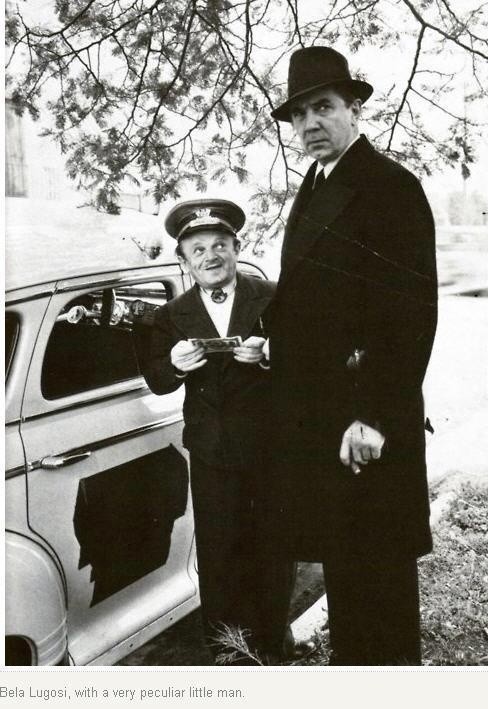
Black Dragons was rushed into production following the attack on Pearl Harbor. It was to begin filming on 17 January 1942, but this was pushed back until 21 January.
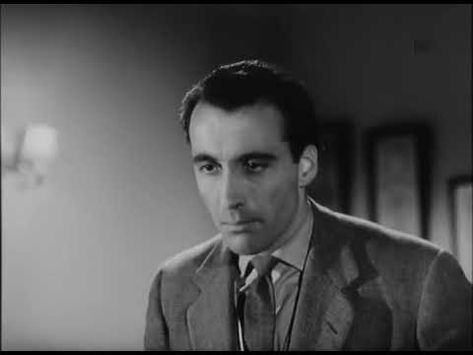


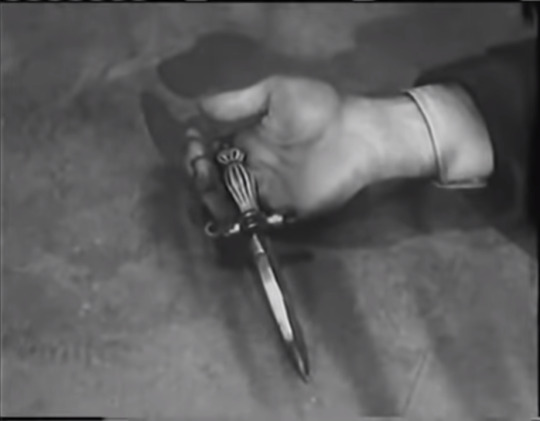
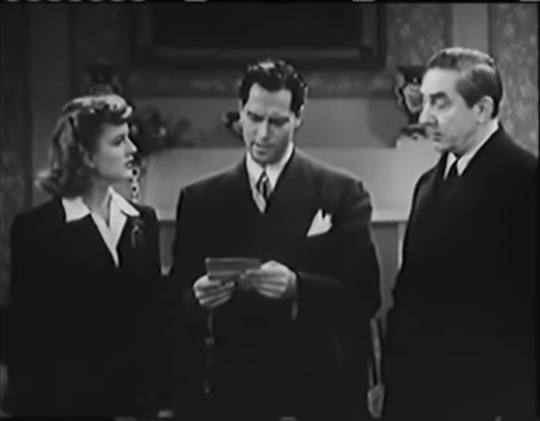

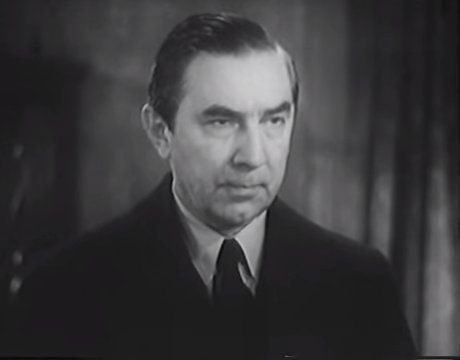
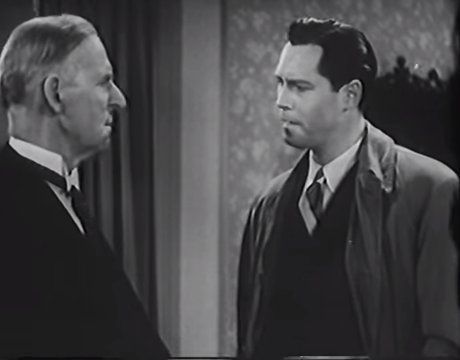

#Clayton Moore#Joan Barclay#Joseph Eggenton#George Pembroke#Robert Frazer#Bernard Gorcey#Bela Lugosi
32 notes
·
View notes
Text
Bluebeard 1944
John Carradine delivers the strongest performance of his career in this taut, suspenseful version of the Bluebeard legend. Carradine is the nefarious Gaston, an artist and puppeteer in 19th century Paris who strangles lovely young models when they fail to meet his exacting standards of perfection. Gaston’s new model, Lucille, learns of his shocking secret and bravely vows to bring him to…
1 note
·
View note
Text


The flattening




#aww#dogs#cute#corgi#cute dog#black corgi#adorable dogs#tri color corgi#the flattening#ellie the tricolor corgi#ellie the pembroke welsh corgi#choji the corgi#waterloo#George the corgi#heaven the corgi
4 notes
·
View notes
Text
Pembroke castle

View On WordPress
#Bataille de Bosworth#Elizabeth Chadwick#Elizabeth I#Georges Duby#Guerre de cent ans#Guerre des deux roses#Guillaume le Maréchal#Henry II#Henry le jeune#Henry VII#Henry VIII#Pembroke castle#Pembrokeshire#Shakespeare#Vikings#William Marshall
2 notes
·
View notes
Text
[In 1534,] the mayor of Hereford reported to Cromwell concerning one Robert Stoper, alias Pewterer. Stoper had declared that he himself was the rightful king of England, that he was the eldest son and heir of the late Earl of Wiltshire, Henry Stafford, and brother of Edward, the third Duke of Buckingham. [...] After Stafford's death the earldom of Wiltshire became extinct, but was given to Thomas Boleyn, father of the future queen, in 1529. [...] It may be that Stoper wanted to lay claim to the earldom, but it was highly unlikely that he would succeed. He was probably resentful of Henry's divorce and his break from Rome, for he had told the mayor, 'I trust to see the queen Katharine's banner spread again, and she shall be queen of England in her old place, by the grace of God'.
Impostures in Early Modern England: Representations and Perceptions of Fraudulent Identities, Tobias Hug
#tudorquotes#sooo the last earl of wiltshire before thomas boleyn was buckingham's brother...? yikes#i mean. i suppose it keeps to pattern. the familial titles#(george made warden of the cinque ports which henry had been anne being made marquess of pembroke#but also. jesus...)#(lol sorry just#i read this and went what wait that was his title also is that true...? and sure enough)#thomas boleyn
1 note
·
View note
Text
Lessons in Lust and Other Illicit Desires (gr63) —TWELVE



↳ A/N One of my favourite chapters!! Can't wait for you guys to read this one 👀 let me know what you think! <3
↳ Series Summary: Sensible, wise, and a hopeless dreamer, Rosaline was used to men not giving her a second glance. She soon discovered it was merely those mundane college boys who were nothing more than simply intimidated by her intellect. What she needed was a man — someone who could impart knowledge beyond the Classics and guide her in discovering her own confidence as a woman. The thrill of sneaking around with the ever-so-charmingly handsome Professor Russell was certainly a bonus.
↳ Pairings: OxfordProfessor!George Russell x Innocent!Student!OC, Max Verstappen x Charles Leclerc (background)
↳ Chapter Word Count: 9.2k
↳ Chapter Warnings: 18+, nsfw, lots of touching, nipple stimulation, fingering, oral sex (f receiving), verbal consent and check-ins, little bit of begging, mention of body hair, cum, aftercare (obviously).

The wood paneled stairwell was quiet, too quiet, the kind of quiet that made Rosaline’s pulse hammer in her ears. It was well past sundown on an average Thursday evening, most of the students shut away in their dorms with their textbooks or already have found a place off campus to waste their time and money. Rosaline knew Pembroke College’s quiet hours by then, three years since her first year at Oxford and living in the accommodations, pinpointing the rare time where there was a lull in foot traffic through the dormitory halls.
It didn’t mean she wasn’t chillingly anxious, however, knowing that it would only take one person’s decision to step out of their room to render her caught. It had seemed like a good idea two hours ago, back when words held more reassurance than the uncertainty of reality that quickly overpowered them. After days of texting almost non-stop and acting completely nonchalant in the lecture hall, Rosaline and George were both itching to see each other outside of campus where they could have proper privacy.
George’s house was off the table since his sister was staying with him for the week and it wasn’t like they could meet up anywhere in the city since the University basically was the city meaning eyes were everywhere. Their only option was Rosaline’s residence: the Pembroke College Dormitories.
But now, sneaking a professor into the dormitories undetected was surely one of the most challenging Rosaline would have to face throughout her entire Oxford career. George had snagged a plain black baseball cap from the backseat of his car to try and conceal his face in the off-chance someone did stumble upon them and he had the collar of his spring trench coat popped just a bit. It was truly a ridiculous excuse of a disguise but what other choice did they have? Desperate times called for desperate measures.
Rosaline clutched George’s hand, glancing over her shoulder at him every few steps as they ascended the worn wooden staircase of the dormitory building. She had never been so aware of just how creaky the floorboards were.
“Are you sure about this?” George murmured, his voice low enough to send shivers down her spine but, at the same time, felt so loud in the silence of the staircase.
“Little late now.” she replied just as quietly, barely heard with her back to him.
At the top of the stairs, they took a left and headed down the quiet hallway lined with numbered doors. Small white boards were affixed to the doors under its bronze number, each housing the residing student’s name (and some also had graffiti from passing peers…there were at least a few immature drawings of penises on some boards).
Rosaline stopped them outside her door and her keys jingled as she pulled them from her coat pocket and hurried to unlock her room. George stood close behind her as if trying to use the shadow of her body to shield himself from any students who might have slipped out of their rooms at that moment. His wandering eyes drifted around the hallway and then upwards to the pendant lights that looked like they were from a hundred years ago and still hung equally in place down the coffered ceiling.
Rosaline grabbed his wrist to pull him into her darkened dorm room with her. Having been a bit too entranced by the interior architecture of the dormitory building, he let out a surprised gasp at her sudden tug as he stumbled after her into her room. The door was shut behind them, locked, and then Rosaline turned on the lights.
“Jesus,” Rosaline exhaled, slumping back against the door, “did we seriously just get away with that?”
Seemingly heaps less stressed than she was, George only smiled at her exasperation and focused on taking a few more steps into her cramped dorm room, glancing around as he toed off his loafers. He replied casually, “We did.”
Rosaline stayed against the door for a moment, watching him in that setting, the room in which she had never once brought back a guy—and certainly not a man—and where she wrote her dreamy stories that she thought would never come true. But here he was, all six-foot-one of him in all his effortlessly handsome glory, eyeing up her desk and her neat stacks of novels and notebooks. George reached out a cautious hand to gently tap at the Mark Twain bobblehead sitting on the corner.
As if suddenly remembering how to be a proper host, Rosaline pushed herself away from the door and held her hand out, “I can take your coat if you want.”
George glanced back at her and then took his laptop bag from his shoulder so he could shrug off his coat to pass over to her with a genuine, “Thanks.”
Rosaline hung it up on the hooks on the back of her door that were already slightly struggling to hold up all the jackets and bags she had stored there. Storage in a dorm room wasn’t much to write home about. She managed to keep everything balanced on the hooks before turning back to her guest.
George was skimming her crooked bookshelf, his finger gliding over the spines. Rosaline wondered if she looked like this when she first visited his house; admiring every detail and corner of the space in which he lived. There was something exciting about it, watching him familiarize himself with her environment.
“It’s not much but…” she shrugged casually, following after him farther into the cramped space.
He finished her statement without tearing his eyes away from her collection, “But you made it your own.”
“I tried.” Rosaline admitted with a soft smile.
George rested a finger atop one of the novels and pulled it out from its place to flip over to the back and read the synopsis. He stated, “I don’t think I’ve heard of this one.”
“It’s a more recent publication.” she drifted over to him. “It’s really good. Rumoured that it’s going to be made into a film but they always ruin the plot that way.”
“Oh, shame.” George chuckled faintly, turning the book over in his hand to see the cover.
Rosaline watched him for a moment, the intrigue in his eyes. She then said, “You can borrow it if you want.”
George looked at her, “Really? I’d love to give it a read.”
Rosaline shrugged modestly, “Of course.”
George set his bag on the end of her bed to open the top and slip the novel inside. His slender fingers toyed faintly at the stack of stapled papers also tucked in his bag, caressing the edges with feather-soft nudges.
“You said you have an assignment to work on?” he asked her.
“Yeah,” Rosaline sighed reluctantly, “A Language paper. I just want to get my outline done tonight.”
George lifted out the stack of papers from his bag to show to her, “I brought some marking to keep myself occupied.”
Rosaline smiled in return, “So…like a study date?”
“Of sorts.” George chuckled and reached back into his bag for the thin box that held his pen.
With a click of the lighter, Rosaline lit her usual candles on her windowsill before placing herself at her desk. She opened her laptop and gathered her resources in a neat row beside her down to her printed rubric and highlighter. She then swirled around in her chair to face George as he rested back on her narrow dorm room bed, propped up in the corner between the wall and the headboard against some pillows. He had his notebook open on his lap and a stack of essays to be marked on the bed beside him, he uncapped his favourite blue fountain pen and glanced up at her at her shift.
“Are you okay over there?” asked Rosaline worriedly, “Sorry it’s not the most comfortable of spots.”
George shook his head with a reassuring smile, “I’m fine. It’s good. I can really work anywhere.”
“Okay, well if you need anything, just let me know.”
They each fell into their work—two passionate literaries. Rosaline, at first, tuned out the world as usual, turning her attention to her research outline and setting herself up for the beginning of the essay that she would have to write over the next week or two. She highlighted lines of the rubric and assignment outline on her desk and prepared her document on her laptop, the click of her keyboard faint in the quiet room.
As she reached a lull in her pace, her eyes raised to look out her window towards the dark courtyard and the roofs of Oxford beyond. In the background of the dorm room’s silence, the sharp scratch of George’s expensive fountain pen on the stacks of essays, crisp and precise, filled the space. She could hear every smooth and formal curve of his handwriting as he wrote corrections and notes in the margins of her classmates’ essays. He was always a firm but fair grader.
She heard the flutter of a page turning, a pause, and then more scratches of the pen.
Finally, Rosaline turned around in her desk chair to face him, tucking a leg up as she folded her arms on the back of it. George was so focused on his work that he didn’t notice her shift at first. His expression was narrowed down at the paper in front of him, deeply focused with his eyebrows slightly furrowed and his thumb resting under his chin with the side of his index finger against his lips. The dorm room was so small that even from across the room, she could see his eyes moving back and forth across the page as he read. Then, with an almost inaudible sigh, he dropped his hand down to draw a sharp line across something in the paper and then wrote out another note in the margins.
Itching to get his attention, Rosaline nudged her glasses up her nose and declared, “I think I need a break.”
At the sound of her voice, George’s intense concentration was broken and he looked over at her. His expression was surprised at first as if he had entirely forgotten she was there. When her words were processed, his lips turned up at the corners and his eyes softened.
“I could go for a break,” he agreed.
Rosaline rose from her chair and took the four short steps across the small room to her bed. George shifted over a little on the narrow twin bed so she could have room to sit beside him, his notebook and a single essay still balanced on his lap, pen between his fingers. He lifted his arm up to welcome her under it so she could squish in beside him on the narrow mattress and he could hold her from falling off.
“Just let me finish this one paper and then I’m yours.” he promised.
Rosaline, tucked up close at his side, watched as he returned his attention to the open essay on his lap. Discreetly, she read along with him, wanting to see what her peers wrote about and how they formatted their essay structure.
“Are you peeking?” George asked with a lighthearted tone.
Rosaline snuggled a little closer, “Not at all.”
He dropped his hand down to write a note in the margin of the page in front of him, struggling slightly to work one-handed with his other arm still around her shoulders. Rosaline set her fingers on the page to help him keep it steady for his pen. He thanked her with a soft smile.
As she watched him work, she tried to keep her comments to herself, wondering why this classmate’s paragraphs were so short and yet still filled with 75% quotations. Not wanting to appear rude and conceited, she kept the thoughts to herself but, deep down, she was sure George was wondering the same. If nothing else, the amount he was writing in the margins was proof of that.
He circled a word and then spoke, “I’m surprised that by third year at Oxford for English Lit there are still some students who don’t know the difference between the three ‘there’s.”
Rosaline leaned closer, “You’re joking.”
“Unfortunately not,” George pointed to the word he just circled and then read it aloud, “‘...expressed by ‘there’—t-h-e-r-e—connection to the setting…’”
“My God.” Rosaline breathed in disbelief.
George sighed and closed the stapled papers before he was even finished marking it, “I think I need a break too.”
As he set the paper back on the stack, Rosaline reached over him to thumb through them, “Have you come across mine yet?”
“Not yet.” George replied, tucking his fountain pen back in its box. “Are you eager for me to get to yours?”
“Depends, are you going to give me 100%?”
“Mm, careful, I don’t want to be caught playing favourites.” he chuckled, “Might just have to give you a 99%.”
Rosaline smiled at their light banter, letting him shift to drop his notebook and papers off the side of the bed and the stack landed flat on the floor with a thud. The box containing his pen was rested gently on top of them. Then, George settled back beside her and the dorm room bed creaked underneath the shift of his weight. Rosaline tried not to cringe.
But he seemed entirely unbothered and, instead, wrapped his arm around her shoulders again to pull their bodies closer together. It wasn’t difficult to snuggle on the cramped single bed—they really had no choice without one of them risking falling off—and neither would dream of complaining about it. They settled a little farther down so they were more so resting on the few pillows Rosaline had meticulously placed on the top of her bed.
Face to face, chest to chest, they were laying eye to eye. Rosaline suddenly felt a little shy. She offered a timid smile and a breathy, “Hi.”
George’s lips pricked up at the corner and he replied just as gently, “Hi.”
“Comfortable?” she asked.
“Mhm,” his hand around her back gently caressed her shoulder with his thumb, “You?”
“Very.” Rosaline agreed.
George’s other hand came up to tuck her hair behind her ear, his eyes roaming across her face and downwards towards her lips. Her heart started hammering in her chest, her fingers ghosting over the fabric of his corduroy button-up directly in front of her, unable to tear her gaze away from his pretty eyes. Had his lashes always been that long?
The warmth of his touch against her cheek had her shivering, the butterflies in her stomach rising into the unmistakable feeling of desire. Since the beginning of their agreement, she had never gone a day of seeing him without those damn butterflies invading her stomach at every given opportunity. She shifted a little, neck and head still supported by his arm around her, and was suddenly very aware of the warmth of his body at every point where they touched.
George stroked her jawline with the pad of his thumb, cradling her cheek in his large hand, and then, ever so slowly, he leaned in. Rosaline’s fingers curled around the edge of his button-up as if needed something to ground herself on and her breath froze in her chest as his lips pressed against hers.
They stayed there, motionless, for a few seconds before he broke away, the soft sound of their lips parting being the only noise in the quiet dorm room. Both of them took just a moment to breathe, George’s thumb still stroking her cheek tenderly, and then they both moved back in.
Rosaline let out a small, barely audible hum against his lips as they shared slow, simple, lingering kisses. Her hands tightened on the front of his shirt as if wanting to draw him closer or not let him pull away. His palm was warm against the side of her face, guiding their soft, close-mouthed kisses with a reassuring touch, and, when his thumb pressed a little harder against her cheek to encourage her lips to part for him, she complied effortlessly.
They were all too used to kissing by then, starting to understand each other’s intricacies and movements and what the other person liked. Kissing horizontally sure was new, however, and Rosaline felt as though it held a whole new layer of intimacy she had yet to experience. She wasn’t oblivious to the between-the-lines of their current positioning, what could easily develop from here; instead, she tried to stay focused in the moment, matching the pace of his lips with her own as their kisses deepened.
George’s hand moved from her face to slide down the silhouette of her body, along the side of her figure. As they kissed lazily like that, his fingers slipped under the fabric of her shirt and lured her closer, pressing indentations into the flesh of her hip. Her body naturally arched against his and he groaned softly into her mouth as their legs tangled together to get impossibly closer.
The narrow dorm room bed creaked beneath them as he shifted to prop himself up at her side a little to start to pull her sweater up and over her head. His kind eyes searched her face for any hesitation as he dropped it to the floor. Rosaline stared up at him with unmistakable longing in her gaze, her hands following his lead as her fingers started to undo the buttons on his shirt one by one. George just stared at her like that for a moment, watching her rouged cheeks and wandering eyes and the gorgeous spread of nervousness and determination in her gaze and every action.
Soon, his shirt was pulled from his shoulders and it, too, was discarded to the floor off the side of the bed. Rosaline’s hands magnetized to his chest as he leaned back down to kiss her, feeling the firm muscle of his pecs under her fingertips that she had missed over the prior few days and weeks since she had last been at his house. Their perfect privacy once more swirled around them and she found herself smiling into the kiss.
She traced the lines of his figure down to the expanse of his faint abs and her fingers grasped onto the waistband of his slacks. Her body arched up towards him again like it had a mind outside of her own. George’s arm easily slid under the small of her back, lifting her hips up towards his with a small groan into her mouth at their closeness and the building friction between them little by little.
He wasn’t quite hard yet but she could still feel the shape of him through his pants and hers, the unmistakable bulge that had her salivating from just a fleeting touch with the emotional weight it held. Rosaline gasped softly into his kiss, falling a little ungraceful in their shared rising desire and the movement of their bodies on the creaky bed; his tongue against her teeth and her lips kissing his cupid’s bow.
“Mm,” George’s nose bumped against hers before trailing kisses along her jaw and down her neck.
Rosaline’s head fell back against the pillow with the rise and fall of her chest getting heavier, lust-blown eyes staring up at the ceiling as he kissed her neck. She raised a hand up to nudge her glasses up her nose again before slinging her arms around his shoulders, trying to breathe and somehow tame her racing heart. Her eyelashes fluttered and her teeth sunk into her kiss-swollen bottom lip, body still trying to push up to find his, instinctively craving any and all friction between them.
“So needy.” George purred against her neck, his hand sliding over the curve of her figure and pulling her hips up against his. His tongue swiped along the column of her neck and she shivered.
“Please,” she breathed to the ceiling, the words falling from her lips without a second thought, “Touch me, please.”
“Touch you?” George echoed, his breath fanning across her neck.
“Please, sir.”
George let out the prettiest moan just beneath her ear at the sweetness of her plea and he nipped at her earlobe. For a moment, she could have sworn she felt his dick twitch in his slacks against her thigh. Then, he was moving farther down her body with a trail of kisses leading over her collarbones and towards the line of her bra, the gentlest of sensations sparking across her skin that had her fingers tangling in the back of his hair.
“Gorgeous girl with such good manners.” George praised lowly. He kissed over the swell of each of her breasts that were snug in her bra before his hands followed to trace the cups. His eyes raised to hers.
The sudden glance of his big blue eyes had her heart leaping in her chest, staring down as he kissed over her breasts and his slender fingers toyed with the straps of her bra as if asking for permission. Her fingers flexed through the roots of his hair.
“Can I take this off you, darling?” George asked softly.
Rosaline could only nod.
“I need words, pretty girl.” he whispered against her skin.
“Yes.” she forced out in a breath, “You can take it off.”
He smiled up at her in that handsome way that had butterflies swirling around in her stomach, right down to the mischievous twinkle in his eye. His fingers looped under the straps of her bra and pulled them down her shoulders, making sure to kiss across her skin as he went as if leaving no fraction of her unappreciated.
The bed creaked again as she took his unspoken lead to shift her body so he could slip his hands behind her to blindly unclip her bra. Rosaline tried not to think of how much practice he must have had to be able to do that so effortlessly. Instead, she focused on the way he dragged the garment away from her chest and down her arms, letting it, too, fall to the floor, all without taking his eyes off of her.
Rosaline couldn’t stop watching him, staring at him stare at her laid out half bare beneath him. His warm hands rubbed up her sides before settling his palms over her breasts and giving them a gentle squeeze. His fingers dusted over her nipples, synchronously framing both between middle and index fingers on either side just to get them to harden up under his touch. His thumbs traced along the underside of her breasts as if mapping her body into his memory while he soaked up the sight of her with hungry eyes.
“Beautiful, beautiful girl.” George breathed.
Her hand tightened in the back of his hair without thought, drawing him closer.
Without a word, his eyes flicked up to hers as he followed her guidance to move closer towards her chest and he dropped out his tongue to lap at one of her nipples. Rosaline pulled in a tight breath at the unfamiliar sensation. Pleased with her reaction, George swirled his tongue around it and then licked at it flatly, smearing her breast in his saliva before he was pulling away and then finally swiping the pad of his thumb over her nipple to see it harden up more.
His eyes then raised to hers, “How’s this?”
“Good.” Rosaline bit her smiling lip. She could feel how flushed her cheeks were.
George’s lips pricked up at the corners, “Yeah?”
She nodded, her hand guiding him back down so he could give the same attention to her opposite breast. Rosaline, of course, knew that nipple stimulation was a common thing and she had written enough about it herself in those endless romantic stories of hers but, as she laid beneath him, the way his tongue and lips felt on her breasts had her toes curling.
George’s eyes fluttered shut and he wrapped his lips around her nipple to take it into his mouth, sucking on it gently. He looked completely unbothered whether he looked ridiculous or not as he lapped at her nipples and played with her breasts. He was draped half on top of her on her dorm room bed, body against body, tangled up together, his large hands all over her and his mouth tasting every inch of her skin. She felt equally warm and covered in shivers.
One thing Rosaline knew she had to work on was not caring so much. He was clearly enjoying himself—with her fingers scratching gently through the roots of his hair and his mouth covering her bare breasts in kisses and licks and eager caresses—and yet something in the back of her mind had her worried if she wasn’t doing enough to please him in return.
“Is this…” she cleared her throat to get some semblance of her voice back, “okay for you?”
George’s eyes opened languidly as if he were in a haze and he pulled away from her breast with a soft, “Yeah. Are you okay?”
“Yeah.” she shifted a little on the bed, “I just…don’t want you to be bored.”
“Bored?” George chuckled dreamily, reassuring her kindly yet firmly, “I am not bored.”
“You promise?”
George’s smile was warm and comforting and he caressed the skin just below her breasts with his cautious thumbs, “I promise. Let me take care of you. That’s our agreement, is it not? Show you how to feel pleasure?”
Rosaline nodded.
“Okay,” George leaned down to kiss her sternum and then left another kiss below that one, his voice nothing but a breath against her skin, “Just relax.”
His open-mouthed kisses were slow and gentle along the length of her torso, trailing down towards her navel calmly yet surely. His lips were warm against her body and the dampness of his mouth left her skin glistening in the location of every kiss as he moved downwards. She wondered if he could feel the way she shivered under his lips.
George ended up at the waistband of her pants, his slender fingers tracing along the edge in a taunting, playful manner. His eyes raised up to hers, asking, “Can I take these off?”
Rosaline nodded, remembering her words with a small, “Yes.”
She could feel her heart doing somersaults in her chest as she watched him pop the button on her pants and then pull the zipper, his motions so calm and cautious and caring. She obediently lifted her hips to help him shimmy them down and then tucked her legs towards her chest so he could tug the material off her ankles. To the floor they went.
She flushed under his gaze, staring up at him as his eyes drifted all over her and he situated himself on his knees between her legs. His hands ran up her shins to her knees to her thighs, not even flinching at the faint prickly hair left over from her last shave a handful of days ago. Instead, George leaned right down and kissed at her calf in those same stomach-whirling open-mouthed kisses.
He moved lower, trailing kisses up her leg and along her inner thigh as his body shifted down towards hers. His kisses slowed as his lips drew higher, drifting almost to the edge of her panties where his fingers were already toying with the waistband.
Rosaline knew what he was insinuating. Something deep within her stirred with a need unlike any other, wanting him to do it and pull her underwear off and give her what she had been curious about for her whole life. But, at that point, although she had already seen all of him, he had yet to see all of her; no one on earth had seen all of her except herself in bathroom mirrors.
“Wait.”
His itching fingers froze and his eyes raised to hers in concern, “We can stop.”
“No.” she rushed out, reaching a hand down as if to cover herself with his face right there, “No, I just…”
George waited quietly for her to find her words, never wanting to rush her. He laid between her legs with his forearms holding himself up on either side of her hips, watching the uncertainty on her face with admirable patience.
Completely entrusting of him, she confessed softly, “I’m nervous for you to see me.”
George gave her hips a reassuring squeeze as he asked, “Would it help if I got naked too?”
Rosaline debated for a moment and then nodded.
George sat back on his haunches and started to unbuckle his belt. She eyed him silently, still laid out on her narrow dorm room bed in only her underwear with her English Professor of all people situated between her legs. Despite the slight absurdity of the situation, she couldn’t deny the intense ache she felt radiating down between her legs and the way her pussy seemed to throb in time with the racing of her heart. George unzipped his pants and got out of them, the bed creaking and groaning under every slight shift of his weight until he was finally bare.
He was fully hard now, his cock standing proudly up and out from his body, but even still, he barely paid it any mind. Instead, he leaned down over her again and pressed his lips to hers in a tender kiss. Rosaline’s hand grasped the back of his neck and she kissed him back, easily parting her lips to welcome in his tongue.
His kisses were reassuring and comforting and his hand rubbed her hip as he kissed her, his thumb caressing over the curve of her skin. When he pulled away for a moment, he promised in a whisper against her lips, “We do nothing you don’t want to do.”
She nodded and blindly grasped his hand to push it down between their bodies as they kissed, guiding him to touch her over the front of her underwear. Yes, she was nervous, but she was still just as horny as ever…finding it to be a balancing act of do or don’t. Her mind was going a mile a minute.
George’s fingers grazed over the front of her panties and down between her legs without any more instruction, gliding his fingertips over the damp material and sharing a small groan into her mouth. Rosaline’s hands framed his face as they kissed sloppily, fingers curling into the roots of his hair a little as warmth poured through her veins at even the faintest of touches from him. She whimpered and her hips pushed up against his touch.
“You’re soaked, darling.” George breathed into her mouth, his words taken by her insistent lips and tongue. He broke away from her lips to rest his forehead against hers for a moment, letting his fingers glide back and forth over the fabric of her panties. He spoke to her lowly, “I’ve barely even touched you and you’ve ruined these.”
“Please,” Rosaline exhaled, fingers twisting through the roots of his hair, her eyes heavy-lidded with lust.
“I’m going to take these off you now, alright?” he asked her gently.
With her nod and her soft ‘yes’, George sat back from her a little, positioned at her side and hovering over top of her, and he moved his hand from between her legs to the waistband of her panties. Rosaline could only stare at him, watching his profile and every flutter of his expression as he pushed down her underwear and finally got her completely naked for his eyes only. She could see the momentary clench of his angular jaw as his eyes raked over her body laid out beside him before his tongue was darting out to wet his lips. Instinctively, she lowered a hand to go to cover herself but right away he was nudging her away.
Without missing a beat, he spoke with a voice filled with gravity, “My God, darling, you’re so gorgeous. Look at you.”
She squirmed a little under his unwavering gaze, luring his eyes back up to her face. There was a fierce emotion in his face now, a fire in his blue eyes that was fueled with lust and desire, something so raw and real that she swore she had never been able to replicate in her writing before. Something so powerful that she could only crave him closer and she pulled his lips back down onto hers.
George’s fingers pushed through the thin, coarse hair along her pubis bone and slipped back down between her legs as he kissed her soft lips, drawing another sweet moan from her throat as he licked his way into her mouth. She shuddered at the feeling of his fingertips gliding across her slick folds, her mind whirling as he blindly explored her body draped out in the privacy of her dorm room. For a moment, she caught herself falling back into that insecure uncertainty, overthinking her entire existence.
But then he was kissing down her neck and breathing praise over her skin in a low rumble, “You feel so good under my hand…so fucking warm, baby.”
His hand was nestled between her legs, caressing her slick pussy and up to her clit and back down again in large messy circles. Rosaline’s breath was falling shallow, clinging onto him as he sped up the pace a little, forcing her to writhe beneath him with a soft cry of pleasure and need for more.
“Shhh,” George hushed her against her cheek, “You’re doing so well, darling.”
Rosaline bit her lip hard, trying to keep herself somewhat quiet as they were faced with the thin walls of her dorm room all around them. When his hand slowed to finally start to press his middle finger inside her, she clutched harder at his shoulders and slung an arm around him, tugging him closer so she could bury her face in his neck, her body arching up against his.
George held her closely, hushing her sweetly against her ear as she whimpered against his neck, and he breathed out a reassuring, “Okay?”
“Yeah.” she stumbled out in a trembling exhale.
“Yeah, you’re such a good girl.” he praised against the shell of her ear, slowly starting to pump his finger into her in tentative motions, letting her familiarize herself with the feeling.
Rosaline’s hips jumped against his hand at the way his single digit grazed the untouched walls of her cunt, exploring her in gentle strokes. It was a strange and unfamiliar sensation—the subtle warmth of his finger inside her, not quite enough to stretch but enough to create a gentle pressure that sent her pulse racing. George moved with deliberate slowness, keeping a steady rhythm, not rushing, allowing her time to adjust to every delicate motion. Little by little, she found herself loosening, unraveling from the tight grip she’d kept on him, surrendering to the unfamiliar pleasure that was slowly consuming her.
Soon, her eyes were finding his again as she leaned back into her pillow with a possessive arm still around his shoulders, keeping them almost nose to nose. Her breaths were falling laboured as he moved his finger a little faster inside her, nudging right up into her in precise motions that had her toes curling.
“Fuck-” she squeaked softly, struggling to keep her eyes open and on his.
“That’s a good girl.” George praised lowly without taking his eyes off of her, watching her every expression.
She was lost in the rhythm of his finger inside her, surprised how much she could feel from only a single digit when her fingers herself never offered her much sustenance of anything. There was something about George that was entrancing and spellbinding, like he knew just how to touch her to get her exactly what she craved.
Rosaline was so out of her mind that she could barely hear her own voice as she breathed out a pleading and pathetic, “Please…more…”
“More?” George echoed, staring into her eyes as his finger slowed inside her, a smile pricked at the corner of his mouth, “Gladly.”
They shared a few more kisses before he was trailing more down her neck, her chest, her stomach, and her legs naturally parted to accept him lower. Rosaline’s heart was racing a mile a minute as she laid there, her wide-eyed gaze focused straight up at her ceiling as he kissed over her hips and thighs.
Her fingers wrung into the rumpled sheets on either side of her body at the thought of someone else so close to her naked body and parts of it that no one had seen before. She could feel his eyes on her down there, his intense stare boring into her pussy, before his gentle fingers followed. The ache that was ever-present in her body craved more of his touch but the shy inexperience that lingered in the back of her mind was making it hard to relax. The last thing she wanted to do was make him uncomfortable.
Anxiously, Rosaline spoke in a whisper, “Sorry if it’s—”
“Beautiful?” George cut her off knowingly, his fingers sliding between her lips to gather up more of that slick wetness that pooled out of her, “Absolutely perfect?”
“I haven’t had a need to shave before so I haven’t—”
“And you won’t need to now.” George shut her swirling mind down with ease, his voice gentle but with a firm stance as if determined to have her understand. His fingers spread out in a v-shape to frame her leaky cunt with his eyes all over her, assuring her seriously, “You’re a grown woman, Rose; there’s nothing wrong with natural. You’re perfect.”
She didn’t know how to reply so she didn’t. Instead, she braved a glance down at him. The sight was startling in the best ways, his lean and built body completely naked in the dull light of her dorm room and splayed out awkwardly on her narrow bed as he rested between her legs. He had his left arm looped under her thigh and his right was still gently playing with her pussy, exploring in gentle touches.
George tutted softly without taking his eyes away from his fingers as they prodded gently at her entrance, speaking almost more to himself than anyone, “And, God, no man in his right mind would complain about a little hair when they have the privilege to go down on a woman.”
Then, his hand—fingers still slick and glistening—pressed against the inside of her left thigh and gently pushed it outward so he could better position himself, his head gently nuzzling against her supple skin. Rosaline shivered and pulled in an anticipatory breath, watching, waiting. She had no opposition, despite the nervousness of the unknown laid out before her very eyes.
George’s eyelashes rested on his cheeks as he moved in a little closer and he nudged his nose against her cunt before breathing in deeply as if to take her in every sense. Finally, his tongue slipped past his lips and gave her a short, shallow stroke right along her entrance. Rosaline’s body flinched at the unfamiliar sensation, gasping faintly, her wide eyes focused down her body to where he was positioned between her legs. His thumb caressed over her thigh comfortingly as he gave her another few soft strokes of his tongue.
When he pulled away, he licked his lips, breathing out a thick, “Christ…so sweet…”
Rosaline took in a shaky breath, fingers twisting in her sheets until he leaned back in for a few more tender laps of his tongue and she couldn’t help but drop her fingers into his hair. George groaned up against her, his hand tightening on her thigh, and he leaned in to press a few, slow, open mouthed kisses to her cunt.
“Oh my God—” Rosaline withered, her mouth slightly agape as she stared down at him between her legs.
Her soft voice had his eyes fluttering open and he stared up at her as he kissed and licked lazily at her cunt, only his nose and up visible to her. It was an unbelievably erotic position, she thought, staring at him like that and feeling every ounce of sizzling pleasure that his mouth gave her. Her fingers tightened in his hair and, almost naturally, her legs spread out wider.
“It’s okay?” he asked her, his voice a lustful drawl like he was intoxicated, words muffled by her body.
She shivered at the feeling of his breath on her skin and she nodded, “Uh huh…yes…”
George lapped at her pussy a little more in full solid strokes before gently suckling on her lips as if wanting to drink her up completely. With a breathless sigh, he turned to kiss over her inner thigh and his fingers caressed her flesh, keeping her spread open for him. Rosaline felt as though her entire body was on fire, like she was aware of every single nerve ending in her body all at once.
Her hand tightened in George’s hair, silently urging him back. The faint tug at his hair had his eyes fluttering shut again and he nestled his face back between her legs, moving his tongue over her cunt again in sloppy strokes before dipping it deeper. Rosaline huffed out a breath and dropped her head back against the pillow while her hips tried to roll against his face. Her clit was aching and the faint nudges of his nose against it were not enough.
“Mm, fuck, darling,” George nearly purred, “you’re so delicious.”
She didn’t even have to open her mouth to ask for more because almost as if reading her mind, he dragged his tongue up to her clit and lapped at it lazily. A tight groan fell from Rosaline’s mouth as her head arched back on the pillow beneath her, legs flinching at the unfamiliar sensation. He gave her clit gentle tongue led kisses that landed wetly over and over until she was squirming and writhing on her dorm room bed, the frame creaking beneath her.
“Please…” she whimpered, tangling her fingers in his hair some more, tugging at the roots a little, “Please, sir…”
George moaned softly against her clit at her words, the vibrations from his mouth making her shudder again. When he wrapped his lips around her clit and suckled gently, an involuntary cry was forced from her and she smacked her hand over her mouth in surprise at the sound. Rosaline felt dizzy with pleasure like she was almost existing outside herself in disbelief that this was really happening, some unheard of force taking over her body and making her react in ways she had never anticipated.
She had heard many stories from friends over the years that oral sex only felt good when done right and, holy shit, Rosaline swore she never felt anything better. She didn’t dare think about the experience that George must have had with the twelve years he had on her in order to make him so good at eating pussy, but she silently thanked the heavens that he somehow ended up between her legs.
With his lips and tongue lapping and suckling at her swollen clit, his fingers made their way back to her leaking pussy, slicking themselves up in her arousal and his spit. Rosaline spread her legs a little wider in silent invitation, fingers tugging more at his hair as her hips nudged up against his face.
Even with her positive body language in response to the tease of his fingers, George still asked her lowly, “This okay?”
Rosaline nodded almost eagerly, “Uh huh…yeah…please…”
He eased his middle finger inside her again slowly, moving effortlessly from how wet she was. He exhaled shakily and went back to tending to her clit with lazy flicks of his tongue as his finger started to curl inside her in steady motions.
“O-Oh my fucking God—” Rosaline withered, her voice sounding completely unlike herself with how pitchy it came out. “Holy shit—”
George found a sufficient pace of tongue and finger, his long lashes fluttering against his flushed cheeks as he tended to her generously. She knew he wanted to do well by her, to be the first to introduce her to this pleasure, but he somehow managed to go about it entirely casually, appearing so relaxed and at ease between her legs. In a way, she felt as though his effortless and modest confidence made it feel better.
The whimpers and moans that tumbled from her lips were nearly involuntary, spurred on by the immense pleasure that was tearing through her body. It was almost embarrassing but she really, truly, couldn’t help it. When he added a second finger inside her, she nearly mewled.
There was a bit more stretch from two fingers than just one, just enough for Rosaline’s inexperienced body to feel a bit more full. It was a strange sensation, tight and stiff, unfamiliar, but eased with the comfort of his tongue lapping at her swollen clit over and over. She didn’t realize how noisy it could be; the harmony of his fingers nudging consistently into her sopping cunt paired with his heavy breaths and eager tongue that was slurping lewdly. It was so incredibly erotic.
Rosaline’s fingers tightened in his hair, tugging his mouth harder against her and he responded generously, giving her just a little bit more as he moaned against her cunt. In doing so, her leg instinctively started to wrap around his head as if trying to close him out from the rising overwhelm but his free hand easily rested against her thigh and gently pushed her open to keep her spread.
“Oh fuck…fuck, don’t stop—” she squealed, feeling her body start to tense, her muscles squeezing tighter around his two fingers that nudged steadily into her. Her head arched back with a tight groan as her eyes screwed shut, knuckles turning white from how she clutched at his hair, “Ahhh— yes, yes, yes, fuck—”
George could feel how close she was—feeling the throbbing of her clit under his tongue and the vice-like grip of her cunt around his fingers—and he moaned hungrily against her. He kept up his ministrations at that same consistent pace with his two fingers thrusting shallowly against the soft walls of her untouched pussy and his tongue and lips tending to her clit until he was nearly drooling down his chin. It was almost like he was drunk on her, eyes heavy-lidded and brain hazy, his hips absentmindedly grinding against her bed from the pleasure that bringing her pleasure pushed through his body.
“G-George…” she sobbed out shakily, “Sir…fuck…I’m gonna come—”
His grip tightened on her thigh, holding her open even as her legs started to tremble. Rosaline swore she was getting dizzy, gasping and whimpering and clutching at his hair and the sheets like she didn’t know what to do with herself, chasing that overwhelming sweet release. Her steadily rising sounds suddenly cut off into silence as she reached orgasm. She completely tensed, freezing right up as she creamed around his fingers and just made every push of his two digits sound that much more lewd.
“Ohhh, shit—” she squeaked as tremors tore through her body in waves of unbridled pleasure.
George groaned against her pussy as he worked her through it, slowing only as her hands pressed flatly to the top of his head to try and get him to let up. Gasping, she laid boneless on her narrow dorm room bed as he pulled away from her with a final wet kiss to her throbbing clit, a string of saliva and her release connecting it to his lips. He wiped his glistening mouth and chin with his just as wet fingers as he shuffled onto his knees and took his hand to his achingly hard cock.
“Do you have a tissue?” George’s voice was ragged and rough, strained with the onset of immense pleasure that she could see spread across his face as his hand started to stroke his dick.
“No,” Rosaline answered hurriedly before tapping her quivering fingertips against her abdomen, right below her navel, “here. Right here.”
“Christ, are you sure?” he panted, although his hand only sped up.
“Uh huh.” she nodded, dilated eyes flicking between his hand and his face.
Her heart rate stayed quick in her chest, her teeth sinking into her bottom lip as she watched his hand work on himself in quick, practiced pumps. She had never seen a man masturbate before and certain not for any reason that had anything to do with her. Now, Rosaline was laid out entirely naked beneath him, watching as he got himself off after being painfully hard from just going down on her.
“Yeah…that’s a good girl,” he panted lowly, “keep looking at me like that, darling, fuck.”
She swore she would never, ever get enough of the sounds he made when he was close; those tight groans and whimper-like breaths. Not to mention the expression on his face of his stormy blue eyes under furrowed brows, complimented by the flush of his cheeks that reached down towards his chest. The clench of his jaw, the flex of his bicep. If he lasted any longer she might have thought she was going to come all over again from just looking at him like that.
But then his hand slowed for just a beat, his left grasping onto her thigh in a snug grip as he reached his climax. Thick white spurts streaked over her abdomen and fell into the hairline just below, painting her skin in filthy creamy ribbons as he let out the handsomest moans she had ever heard. George’s hand worked himself through it a little more, pulling every last drop out of him until the last little bit oozed out of the tip and onto his fingers.
“Jesus Christ…” he muttered, his voice thick through the way he panted for breath.
Rosaline’s chest was heaving and she swore there might have been stars in her eyes as she stared up at him, her mouth slightly agape, in awe.
George reached his clean hand up to swipe his thumb across her cheek tenderly, “You okay?”
“Yeah,” she breathed, trying to get her brain out of its pleasure-filled reverie to form some semblance of an answer, “Yeah, I’m…that was…incredible.”
George’s face moulded into a smile and he stroked her cheek again, “Yeah?”
She nodded up at him and reached a hand up to grasp his wrist comfortingly, the heat of her palm against his skin feeling like fire. He thumb dragged over her bottom lip and, instinctively, her lips parted to take the tip of his thumb in her mouth.
“Let me clean you up,” he breathed, his words a little shaky from their activities, “Tissues?”
Rosaline turned her head to look towards her nightstand, allowing his thumb to pull away from her mouth with a thin string of saliva connecting them briefly, and she gestured to the second shelf. George carefully shifted out from between her legs and climbed off the creaky twin bed so he could grab a few tissues from the box. She laid there patiently—feeling a little silly, naked and covered in cum and waiting—as he wiped off his hands first and then grabbed some more to politely wipe the mess from her abdomen.
At first, she watched him clean her up, the gentle swipes of the tissue over her soiled skin and every precise fold of the thin cloth to make sure every drop was moped up. She was so used to being independent that it felt strange at first; having someone do something so intimate to simply clean her up. In thinking so, her attention shifted from his hand to his face as he had one knee on her bed and was leaning over her. His eyebrows were furrowed ever so slightly in the middle in concentration, his hair an absolute mess atop his head from her fingers pulling at it and his cheeks were still flushed and lips swollen and set in a natural line.
George was careful with his touches as if he knew how sensitive she would be, especially as he took a few clean tissues between her legs to mop up the worst of the overpowering slickness that covered her cunt and thighs. She flinched in surprise at that, earning a small breathy “sorry” from him.
He joined her right after, unbothered by the ridiculous creak of the bed frame as he settled beside her and wrapped her up close on the narrow bed. They shared a few kisses in which she could taste herself on his tongue. The realization made her smile softly, gentle fingers ghosting over his jawline to feel it flex as they kissed lazily. Dreamy, surreal. She wanted to pinch herself but didn’t want to wake up either.
After a while of kissing and snuggling naked, they were dressed and George was pulling his bag over his shoulder. He opened an arm out to her to draw her into his chest, pressing a lingering kiss to her cheek as her arms snaked around his middle. He sighed deeply; a heavy sound that caught her attention. She pulled back just enough to meet his eyes, noting his downcast gaze. Her hands splayed across his back over the fabric of his jacket as if to keep him from pulling away in any sense of the term.
“What is it?” she asked softly.
George pulled her closer again and his breath fell into her hair with another exhale before he spoke in a timid whisper, “I don’t like how this feels like some weird friends with benefits situation we have going on here.”
Rosaline felt her heart clench. Her fingers faintly grasped onto the back of his jacket. This was it, she was sure, she just let him in and now he was going to push her away and she would never be able to show her face in public and—
Before she could overthink too much, he continued, “I want to take you out properly.”
Oh.
She shifted in his arms to look at his face again, “Are you serious?”
“Doesn’t have to be a date.” he added lightly, his voice barely a whisper as if he was suddenly nervous, reaching a hand up to trace the lines of her face with his fingertips from her nose down to her lips with his other arm still gently around her waist, holding her close, “Just…something more than just sneaking around like horny teenagers.”
A small smile flickered over Rosaline’s face and she stared into his ocean eyes adoringly, “I’d like that.”
“Perhaps lunch?” he offered, “Off campus? I might have a place in mind.”
She nodded, biting back the grin that threatened to overpower her. She didn’t want to look like an absolute lunatic when he was asking her out. With another nod, she managed out a casual, “Yeah, that’d be really nice.”
“Okay,” he leaned in to kiss her cheek again and his hand rubbed over the small of her back in parting as he stepped away and towards the door of her dorm room, “I’ll text you.”
“‘Kay.” Rosaline purred dreamily, following him to the door to see him out.
With one more quick kiss goodbye, he was slipping out into the hallway and tugging down the brim of his inconspicuous baseball cap to shield his eyes from any passing students, disappearing in a rush of forbidden reverie towards the dormitory staircase.

♡ Enjoying my content? Support my writing here :)
♡ None of the original writing on this blog may be reproduced, reposted, or transmitted in any form or by any means, electronic or mechanical, including photocopying, recording, or by any information storage and retrieval system, without permission in writing from the author.
#📖#george russell x oc#george russell smut#george russell fanfic#george russell fic#f1 fanfic#f1 fic#formula one fic#f1 fluff#f1 smut#f1 imagines#f1 x reader#f1 x oc#f1 imagine#professor crush#professor x student#experienced x innocent#formula 1 x reader#formula 1 x oc#george russell x reader
98 notes
·
View notes
Text
𝐎𝐂 𝐱 𝐎𝐂 𝐂𝐨𝐧𝐧𝐞𝐜𝐭𝐢𝐨𝐧𝐬: Part 1, 1870-1960
⤷ part 2 (1961-2010) | part 3 (minor ocs)
An open offer for oc x oc interactions for all of my HP OCs and the types of relationships that they’re open for!
This functions as a reset for all of my OCs’ dorms and as such, there are anywhere from 1-4 open beds in most of the dorms. OCs of the same gender, house, and year share a dorm. There’s also a soft reset on friendships, so please let me know about those too! One OC is available for a love interest.
If you are interested, please comment, reblog, or send an ask with: the name of your OC, the name of my OC, and the preferred relationship!
Eras Involved: HPHL, Victorian, WW1, FBAWTFT, Marauders

𝙷𝙾𝙶𝚆𝙰𝚁𝚃𝚂 𝙻𝙴𝙶𝙰𝙲𝚈 𝙴𝚁𝙰
Orla Deidre O’Rourke | profile | starts hogwarts in 1885

house: slytherin
date of birth: september 6, 1873 (virgo)
pronouns: she/her
blood status: pureblood
personality types: infj & enneagram type 5w4
extracurriculars: none
professions: ancient runes translator
faceclaim: megan follows
love interest: cillian lynch
dormmates: priscilla parkinson | open | open | open
open for: friendships, 3 dormmates
Cillian Cathal Lynch | profile | starts hogwarts in 1887

house: slytherin
date of birth: march 5, 1874 (pisces)
pronouns: he/him
blood status: pureblood
personality types: entj & enneagram type 3
extracurriculars: none
professions: magical object appraiser
faceclaim: hugh grant
love interest: orla o’rourke
dormmates: ignatius butler | maurice flint | theophilus nott | open
open for: friendships, rivals, 1 dormmate
Tadhg Oisín Lynch | profile | starts hogwarts in 1887

house: gryffindor
date of birth: march 5, 1874 (pisces)
pronouns: he/him
blood status: pureblood
personality types: istp & enneagram type 7w6
extracurriculars: quidditch (keeper)
professions: cursebreaker
faceclaim: rob lowe
love interest: niamh kelly
dormmates: dermot kennedy | john cunningham | philip thompson | gabriel sapieha (slytherindisaster)
open for: friendships
Niamh Brigid Kelly | profile | starts hogwarts in 1886

house: ravenclaw
date of birth: february 9, 1875 (aquarius)
pronouns: she/her
blood status: muggleborn
personality types: enfp & enneagram type 7w8
extracurriculars: prefect
professions: auror
faceclaim: robin wright
love interests: tadhg lynch (tadhg lives au timeline, primary) | tbd (canon timeline)
dormmates: samantha dale | open | open | open
open for: 3 dormmates, friendships
Vincent George Augustus Fitzroy | profile | starts hogwarts in 1887

house: slytherin
date of birth: october 4, 1875 (libra)
pronouns: he/him
blood status: muggleborn
personality types: istp & enneagram type 6w5
extracurriculars: tbd
professions: thief/pickpocket, tbd
faceclaims: lucas jade zumann & ben lloyd hughes
love interest: brianna o’rourke
dormmates: tiernan o’rourke jr. | open | open | open
open for: friendships, 3 dormmates
Brianna Florence O’Rourke | profile | starts hogwarts in 1887

house: hufflepuff
date of birth: march 26, 1876 (aries)
pronouns: she/her
blood status: pureblood
personality types: infp & enneagram type 9
extracurriculars: prefect, headgirl
professions: potioneer
faceclaims: amybeth mcnulty & charlotte spencer
love interest: vincent fitzroy
dormmates: open | open | open | open
open for: friendships, 4 dormmates

𝚅𝙸𝙲𝚃𝙾𝚁𝙸𝙰𝙽 𝙴𝚁𝙰 | starts hogwarts 1892
Maxwell Eamon “Max” Pembroke | profile

house: hufflepuff
date of birth: october 31, 1880 (scorpio)
pronouns: he/him
blood status: half-blood
personality types: istp & enneagram type 5w6
extracurriculars: quidditch (seeker)
professions: professional quidditch player (seeker, caerphilly catapults & kenmare kestrels)
faceclaim: leo suter
love interest: ivy anders (@kc-and-co)
dormmates: simon battersea | open | open | open
open for: 3 dormmates, friendships (tentatively, max is a big homebody & quidditch teammates are probably best)
Georgiana Reva “Georgie” Parsons | profile

house: gryffindor
date of birth: january 31, 1881 (aquarius)
pronouns: she/her
blood status: muggleborn
personality types: enfj & enneagram type 1w9
extracurriculars: prefect
professions: lawyer/barrister
faceclaim: simone ashley
love interest: angelo della rovere (@potionboy3)
dormmates: open | open | open | open
open for: friendships, 4 dormmates
Edmund Dermot Ferdia Kennedy | profile

house: gryffindor
date of birth: april 10, 1881 (aries)
pronouns: he/him
blood status: pureblood
personality types: estj & enneagram type 1
extracurriculars: prefect, headboy
professions: treasury department employee
faceclaim: jonathan bailey
love interest: lottie gallagher (@slytherindisaster)
dormmates: open | open | open | open
open for: friendships, 4 dormmates
Minerva Aileen Kennedy | profile

house: ravenclaw
date of birth: april 10, 1881 (aries)
pronouns: she/her
blood status: pureblood
personality types: entp & enneagram type 9w8
extracurriculars: the hogwarts women writers club
professions: author
faceclaim: claudia jessie
love interest: adonis demiurgos (@endlessly-cursed)
dormmates: open | open | open | open
open for: 4 dormmates, friendships, rivals
Simon Percival Theodore “Wex” Battersea | profile

house: hufflepuff
date of birth: june 21, 1881 (gemini)
pronouns: he/him
blood status: muggleborn
personality types: istj & enneagram type 9w1
extracurriculars: none
professions: the earl of wexford
faceclaim: william moseley
love interest: nilüfer sultan (@endlessly-cursed)
dormmates: max pembroke | open | open | open
open for: 3 dormmates, friendships
William John Devlin | profile

house: ravenclaw
date of birth: july 5, 1881 (cancer)
pronouns: he/him
blood status: muggleborn
personality types: isfp & enneagram type 4w5
extracurriculars: quidditch (seeker)
professions: artist, laborer
faceclaims: luke thompson & elliot grihault
love interest: josie edwards (@slytherindisaster), primrose gray (arranged fiancée, @endlessly-cursed)
dormmates: open | open | open | open
open for: 4 dormmates, friendships (tentative because he’s very private and doesn’t open up easily, he always expects to be ridiculed due to being illegitimate)

𝚆𝙾𝚁𝙻𝙳 𝚆𝙰𝚁 𝟷 𝙴𝚁𝙰
Ophelia Anne Lovell | profile | starts hogwarts in 1904

house: hufflepuff
date of birth: november 3, 1892 (scorpio)
pronouns: she/her
blood status: half-blood
personality types: esfj & enneagram type 2w3
extracurriculars: prefect, headgirl
professions: nurse, owl air force, tbd
faceclaim: conor leslie
love interests: patrick simmons (@potionboy3), klara belikova (@fischerfrey)
dormmates: open | open | open | open
open for: friendships, 4 dormmates
Linus Matthew Sullivan | profile | starts ilvermorny in 1905

house: wampus (attended ilvermorny)
date of birth: november 26, 1893 (sagittarius)
pronouns: he/him
blood status: muggleborn
personality types: infj & enneagram type 6
extracurriculars: tbd
professions: newsboy, soldier, tbd
faceclaim: joseph mazzello
love interest: maritza krum (@potionboy3)
dormmates: reuben o’dwyer | open | open | open
open for: friendships, 3 dormmates
Colm Michael O’Shea | profile | starts hogwarts in 1905

house: gryffindor
date of birth: august 27, 1894 (virgo)
pronouns: he/him
blood status: presumed muggleborn, but is actually half-blood
personality types: estp & enneagram type 6w5
extracurriculars: quidditch (keeper)
professions: bartender, soldier, intelligence operative, tbd
faceclaim: josh hartnett
love interest: ione avery (@cursed-herbalist)
dormmates: rory o’neill | grant abbott | open | open
open for: friendships, 2 dormmates

𝙵𝙰𝙽𝚃𝙰𝚂𝚃𝙸𝙲 𝙱𝙴𝙰𝚂𝚃𝚂 𝙴𝚁𝙰
Rory Patrick O’Neill | profile | starts hogwarts in 1905

house: gryffindor
date of birth: may 8, 1894 (taurus)
pronouns: he/him
blood status: muggleborn
personality types: istj & enneagram type 6w5
extracurriculars: quidditch (seeker), quidditch captain
professions: professional quidditch player (seeker, ballycastle bats), quidditch coach (ballycastle bats)
faceclaim: jamie dornan
love interests: francesca ashby (deceased), ethel malinda (@fischerfrey)
dormmates: colm o’shea | grant abbott | open | open
open for: friendships, 2 dormmates
Aisling Maeve Lynch | profile | starts hogwarts in 1918

house: hufflepuff
date of birth: april 22, 1907 (taurus)
pronouns: she/her
blood status: half-blood
personality types: isfp & enneagram type 6w7
extracurriculars: prefect, headgirl
professions: aurologist
faceclaims: hannah dodd & shay rudolph
love interest: jojo sapieha (@slytherindisaster)
dormmates: open | open | open | open
open for: friendships, 4 dormmates

𝙼𝙰𝚁𝙰𝚄𝙳𝙴𝚁𝚂 𝙴𝚁𝙰
Oscar Daniel Lynch | profile | starts ilvermormy in 1971 and hogwarts in 1974

house: horned serpent, slytherin
date of birth: february 22, 1960
pronouns: he/him
blood status: pureblood
personality types: intp & enneagram type 3w4
extracurriculars: tbd
professions: (wrongful) azkaban prisoner & tbd
faceclaim: chris o’donnell
love interest: open (heterosexual, second chance romance? i never stopped loving you?)
dormmates: open | open | open | open
open for: a love interest, friendships, 4 dormmates, rivals
#oc x oc connections#hphl#hp victorian era#hp ww1 era#hp wwi era#fbawtft oc#hp marauders era oc#all provided information may be subject to change#debating a bunch of random changes from switching the lynch twins and orla to hl mc’s year#to giving the kennedys a title to moving simon’s fc (at least) to the riddle era
4 notes
·
View notes
Text
HMS Royal Sovereign - 1804
She was a yacht built in 1804 for King George III how used her from 1805-1820. On 25 June 1814, a naval parade was held at Spithead to celebrate the Treaty of Paris.

The model here was created by an unknown builder and shows the yacht not only from the outside but also from the inside. It is not known whether it served as a presentation object for the king or whether he owned it himself as a decorative model.(x)
The day after the parade, the Prince Regent, the King of Prussia and the Emperor of Russia embarked on the Royal Sovereign and led the 15 ships of the line and 31 frigates to sea where battle manoeuvres were observed from the flagship of the fleet.

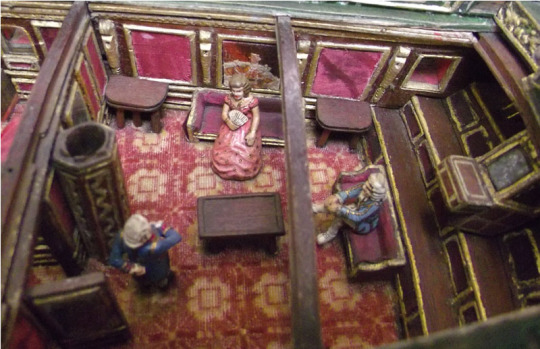
In October 1824, the Duke of Clarence used the Royal Sovereign for a tour of the fleet at Spithead, where the ship's to and fro forced a warship, the brig HMS Redwing, to fire the royal salute seven times. Clarence used the yacht to visit four ships on this occasion.
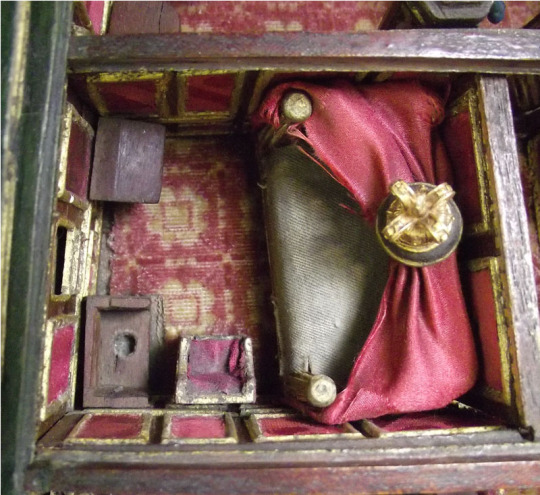
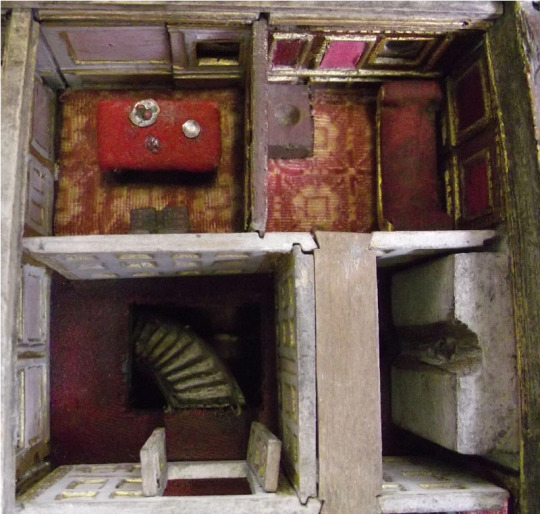
On 19 February 1838, Captain Samuel Jackson transferred from the liner HMS Bellerophon to command the Royal Sovereign. He was both master of the ship and commander-in-chief of Pembroke Dockyard. He retained command until he was promoted to Rear Admiral on 23 November 1841.

The Royal Sovereign was commissioned as a depot ship in Pembroke Dockyard in November 1849 and was broken up a year later.
#naval history#ships who made history#hms royal sovereign#yacht#1804-1850#royal yacht#shipmodel#age of sail
102 notes
·
View notes
Text
Wishes for Mary & George
Mandatory:
poop jokes
Likely:
Spanish Adventure is shown in full ridiculousness with the worst fake beards EVER
1623(? I think) carriage incident
Reasonable hopes:
Going deep on the extremely weird adoptive brother/stepfather relationship of George and Charles
Francis Bacon is there and gay (I thought this was a long shot but I see FRANCIS BACON IS CAST!)
George horrifies the French court by putting his feet up on a chair
James is depicted as motivated not by sex as much as by love, and it's by understanding this that George achieves supremacy
James repeatedly falls off his horse
Longshot:
Henry Frederick
Philip Herbert, 4th Earl of Pembroke
William Monson and/or Arthur Brett
Ludovic Stewart
Desperate pipe dream:
GEORGE DOESNT POISON JAMES
24 notes
·
View notes
Text
Pembroke College, Oxford Turns 400
Pembroke College, Oxford first opened its gates to students on August 6, 1624. That’s nearly 300 years later than Pembroke College, Cambridge, but I just happened to notice that this nice round anniversary, this quatercentenary, was upon us, and also that I had written about some of its famous alum, and am likely to write about others: these include Samuel Johnson, George Whitefield, J.R.R.…

View On WordPress
3 notes
·
View notes
Text










#armor#plate armor#dont ask me why they comboed syria iran and turkey instead of giving them each their own i got no idea
2 notes
·
View notes
Text
Yes, Really

#Knackered Yet Living#KYL#Creator Fiction#Beloved Darling#George Hughes#Pembroke Welsh Corgi#Bin Box Reply-Inspired#Creator-Character Talk Moments#“I couldn't resist the dialogue in my head”#“Fingers admitted to the ICU. Again.”#Kal's Panel Sessions#“Dognabbit."#Silly Canine#Glimpse of Art
2 notes
·
View notes
Note
Hello, can you explain who sided with who from the peerage during Henry VI Readeption? Which side had more support?
Hi! I'm just going to post an excerpt from False, Fleeting, Perjur'd Clarence: George, Duke of Clarence, 1449-7 by Michael Hicks, which sums up the situation:
“The Readeption had enjoyed the military support of the Dukes of Somerset and Exeter, the Marquis Montagu, the Earls of Devon, Dorset, Pembroke, Oxford and Warwick, Viscount Beaumont, and Lords St. John, Wenlock and Camoys. Of those who had helped restore Henry VI, Clarence, Shrewsbury, Stanley, FitzHugh and Scrope had withdrawn their support; no former Lancastrians [ie: the ones who had made peace with Yorkist England in the 1460s] had returned to the fold and nobody had defected from Edward IV. On Edward’s return to London, he was accompanied by five dukes, six earls and thirteen barons, most of whom had probably fought at Tewkesbury. Lords Say and Cromwell had been killed at Barnet and other peers participated in the Kentish campaign against Thomas Neville, Bastard of Fauconberg. From this it is clear that almost the whole peerage, certainly all the greater magnates, were actively involved in the 1471 campaign. Edward’s army had a strong family tinge, as it included both his brothers, his brother-in-law Suffolk, Earl Rivers and the husbands of five of the Wydeville sisters. It was not merely a faction: there were others without court connections, such as Norfolk and Cobham. Clearly Edward enjoyed the general support of the peerage […]’
(If there's anything this hasn't touched upon, or if it's gotten anything mixed up, please feel free to add on or/and correct it!)
#ask#this question nearly broke me until I realized a ready-made answer was available lol#wars of the roses#english history#15th century#there's some people the excerpt didn't include#like Henry Percy Earl of Northumberland who the Lancastrians expected to lend support to them#Northumberland doesn't seem to have actively committed to either side but his conduct very clearly favored Edward IV#PS: I'm super curious if the 'Cobham' mentioned here is a relative of Eleanor Cobham?#I haven't been able to find any more information on him :(
5 notes
·
View notes
Text
Ages of English Princesses at First Marriage
I have only included women whose birth dates and dates of marriage are known within at least 1-2 years, therefore, this is not a comprehensive list. The average age at first marriage among these women was 16.
This list is composed of princesses of England when it was a sovereign state, prior to the Acts of Union in 1707.
Eadgyth (Edith) of England, daughter of Edward the Elder: age 20 when she married Otto the Great, Holy Roman Emperor in 930 CE
Godgifu (Goda) of England, daughter of Æthelred the Unready: age 20 when she married Drogo of Mantes in 1024 CE
Empress Matilda, daughter of Henry I: age 12 when she married Henry, Holy Roman Emperor, in 1114 CE
Marie I, Countess of Boulogne, daughter of Stephen of Blois: age 24 when she was abducted from her abbey by Matthew of Alsace and forced to marry him, in 1136 CE
Matilda of England, daughter of Henry II: age 12 when she married Henry the Lion in 1168 CE
Eleanor of England, daughter of Henry II: age 9 when she married Alfonso VIII of Castile in 1170 CE
Joan of England, daughter of Henry II: age 12 when she married William II of Sicily in 1177 CE
Joan of England, daughter of John Lackland: age 11 when she married Alexander II of Scotland in 1221 CE
Isabella of England, daughter of John Lackland: age 21 when she married Frederick II, Holy Roman Emperor, in 1235 CE
Eleanor of England, daughter of John Lackland: age 9 when she married William Marshal, Earl of Pembroke in 1224 CE
Margaret of England, daughter of Henry III: age 11 when she married Alexander III of Scotland in 1251 CE
Beatrice of England, daughter of Henry III: age 17 when she married John II, Duke of Brittany in 1260 CE
Eleanor of England, daughter of Edward I: age 24 when she married Henry III, Count of Bar in 1293 CE
Joan of Acre, daughter of Edward I: age 18 when she married Gilbert de Clare, Earl of Gloucester in 1290 CE
Margaret of England, daughter of Edward I: age 15 when she married John II, Duke of Brabant in 1290 CE
Elizabeth of Rhuddlan, daughter of Edward I: age 15 when she married John I, Count of Holland in 1297 CE
Eleanor of Woodstock, daughter of Edward II: age 14 when she married Reginald II, Duke of Guelders in 1332 CE
Joan of the Tower, daughter of Edward II: age 7 when she married David II of Scotland in 1328 CE
Isabella of England, daughter of Edward III: age 33 when she married Enguerrand VII, Lord of Coucy in 1365 CE
Mary of Waltham, daughter of Edward III: age 16 when she married John IV, Duke of Brittany in 1361 CE
Margaret of Windsor, daughter of Edward III: age 13 when she married John Hastings, Earl of Pembroke in 1361 CE
Blanche of England, daughter of Henry IV: age 10 when she married Louis III, Elector Palatine in 1402 CE
Philippa of England, daughter of Henry IV: age 12 when she married Eric of Pomerania in 1406 CE
Elizabeth of York, daughter of Edward IV: age 20 when she married Henry VII in 1486 CE
Cecily of York, daughter of Edward IV: age 16 when she married Ralph Scrope in 1485 CE
Anne of York, daughter of Edward IV: age 19 when she married Thomas Howard in 1494 CE
Catherine of York, daughter of Edward IV: age 16 when she married William Courtenay, Earl of Devon in 1495 CE
Margaret Tudor, daughter of Henry VII: age 14 when she married James IV of Scotland in 1503 CE
Mary Tudor, daughter of Henry VII: age 18 when she married Louis XII of France in 1514 CE
Mary I, daughter of Henry VIII: age 38 when she married Philip II of Spain in 1554 CE
Elizabeth Stuart, daughter of James VI & I: age 17 when she married Frederick V, Elector Palatine in 1613 CE
Mary Stuart, daughter of Charles I: age 10 when she married William II, Prince of Orange in 1641 CE
Henrietta Stuart, daughter of Charles I: age 17 when she married Philippe II, Duke of Orleans in 1661 CE
Mary II of England, daughter of James II: age 15 when she married William III of Orange in 1677 CE
Anne, Queen of Great Britain, daughter of James II: age 18 when she married George of Denmark in 1683 CE
34 notes
·
View notes
Note
wait George Villiers was a shitty person? what did he do?
Hi! I’d like to preface my answer to this question by saying that I’m not a historian (I have a degree in linguistics and literary studies), and all of my information comes from doing a lot of research regarding George on my own, therefore there might be a lot more info on what exactly he did or did not. So if there is someone more knowledgeable about this, please correct me.
What George Villiers did, and, quite frankly, how his career had gone could be described by a line reportedly spoken by Queen Anna of Denmark to Abbot, the archbishop of Canterbury (and Pembroke), two people who worked together to install George in James’s bedchamber as a favourite “You and the rest of your friends know not what you do. I know your master better than you all, for is this young man be once brought in first person he will plague must be you that labour for him.”
As opposed to the previous favourite Somerset (Robert Carr), Gorge was deeply ambitious as he not only wished to enrich himself while in favour, but he also wanted to become an important player in the political sphere. (If I dare say so myself, I believe, that his time as a politician, would not be half as bad if he had received a proper training. Tho he was undoubtedly a shitty, to put it mildly, person) He knew that key to his success was the affection and love of the king as he could literally take everything that was given to him and make him once again the poor George that he once was. (I really do not want to talk about their relationship as it would take more than a sentence to summarise it). Thans to how rapidly he climbed the social ladder and received more titles and positions at the court which in turn allowed him to have actual sway in the country’s internal and external politics. Geore was also keenly aware that apart from the royal favour he needed connection to face his opposition (the ancient families of England). So patronage, it was something common (even now). He installed his immediate family at the court and secured them positions, (mmm nepotism), the marriage market was also fair play as George slowly but surely arranged marriages for people in his family, win-win situation.
Addressing his now growing family, his wife – Kate Manners, became one as he possibly kidnapped and raped her. (There are some rumours that he “what-a-surprise got locked” with her in one building so after that they just had to get married.) It was a marriage for the money she could bring, and the connections did not hurt either, a nice bonus, one might even say. He also made a deal with Edward Coke to marry off his daughter (her mother protected her fiercely) to his brother. It is said that she cried during the ceremony.
In lieu of the theme of nepotism, as he slowly transformed the royal bedchamber into a place of the de facto lawmaking. He packed every place possible (to an extent) with people what would back him up. For that he was notoriously selling patronages, titles, and land, especially in Ireland where law did not hold him so much. Literally whenever the parliament tried to remove him from power because of how badly (Imo he would have done much better if he had training and not just gone with the general fuck around and find out rule.) he did his job, and people were fed up with him. He started a whole 20D chess match with Richelieu which was pointless, started a few campaigns that ended with him often not paying the soldiers (I mean no one would stab him to death over such thing… right), the last one being a pointless siege that only made England loose troops and money. (He could have one that one, he was so close to it, but he had to celebrate the possibility of victory rather than making people sing papers). He enraged the protestant England by helping to offer help France with fight off Protestants. What else… oh yes, he almost sa’d Anne of Austria which just… mmm the flavour of historical silencing of women, misogyny and men who just have dick measuring contests because.
Tho what I do not believe, and what many line up with, is that he did not poison James (or at least wasn’t aware of doing so??) because I think that he would gain more from helping the king survive than just killing him.
Sources
Bellany, Alastair, and Thomas Cogswell. 2015. The Murder of King James I. New Haven: Yale University Press.
Cogswell, Thomas. 2017. James I (Penguin Monarchs). Penguin UK.
Lockyer, Roger. 2014. Buckingham. Routledge.
Stewart, Alan. 2014. The Cradle King. St. Martin’s Press.
Veerapen, Steven. 2023. The Wisest Fool. Birlinn Ltd.
10 notes
·
View notes